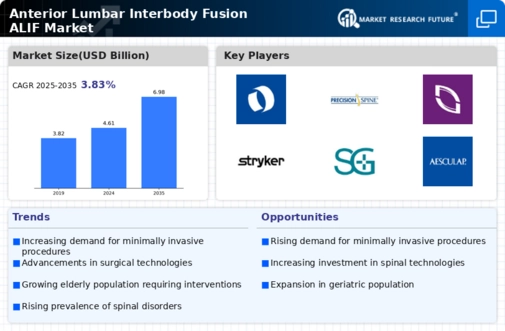Rising Prevalence of Spinal Disorders
The increasing incidence of spinal disorders, such as degenerative disc disease and spinal stenosis, is a primary driver for the Anterior Lumbar Interbody Fusion ALIF Market. As populations age, the demand for effective surgical interventions rises. According to recent data, spinal disorders affect a significant portion of the population, leading to a surge in surgical procedures. This trend is expected to continue, with estimates suggesting that the number of spinal surgeries could increase by over 20% in the next five years. Consequently, the Anterior Lumbar Interbody Fusion ALIF Market is likely to experience substantial growth as healthcare providers seek advanced solutions to address these conditions.
Increased Investment in Spine Surgery Research
The surge in investment for research and development in spine surgery is a crucial driver for the Anterior Lumbar Interbody Fusion ALIF Market. Both public and private sectors are allocating substantial funds to explore innovative surgical techniques and materials. This influx of capital is fostering collaborations between academic institutions and medical device manufacturers, leading to the development of advanced ALIF solutions. Recent reports indicate that funding for spine-related research has increased by over 30% in the past two years. This trend is expected to enhance the quality and efficacy of ALIF procedures, thereby stimulating market growth.
Rising Awareness and Education on Spine Health
The growing awareness and education regarding spine health are pivotal in shaping the Anterior Lumbar Interbody Fusion ALIF Market. Initiatives aimed at educating the public about spinal health and the benefits of surgical interventions are gaining traction. Healthcare organizations are increasingly promoting awareness campaigns that highlight the importance of early diagnosis and treatment of spinal disorders. This heightened awareness is likely to lead to an increase in patient consultations and subsequent surgical procedures. As a result, the Anterior Lumbar Interbody Fusion ALIF Market is expected to expand as more individuals seek effective solutions for their spinal health issues.
Growing Demand for Outpatient Surgical Procedures
The shift towards outpatient surgical procedures is significantly influencing the Anterior Lumbar Interbody Fusion ALIF Market. Patients increasingly prefer outpatient settings due to the convenience and reduced costs associated with shorter hospital stays. Recent statistics reveal that outpatient spine surgeries have seen a growth rate of approximately 15% annually. This trend is likely to continue as healthcare systems adapt to patient preferences and strive to improve efficiency. Consequently, the Anterior Lumbar Interbody Fusion ALIF Market is poised to benefit from this shift, as more facilities adopt ALIF procedures in outpatient settings.
Technological Advancements in Surgical Techniques
Technological innovations in surgical techniques are transforming the Anterior Lumbar Interbody Fusion ALIF Market. The advent of minimally invasive surgical methods has enhanced patient outcomes, reduced recovery times, and minimized complications. These advancements include the use of robotic-assisted surgery and improved imaging technologies, which facilitate precise surgical interventions. Data indicates that minimally invasive techniques can reduce hospital stays by up to 50%, making them increasingly attractive to both patients and surgeons. As these technologies continue to evolve, they are expected to drive further adoption of ALIF procedures, thereby propelling the market forward.


















Leave a Comment